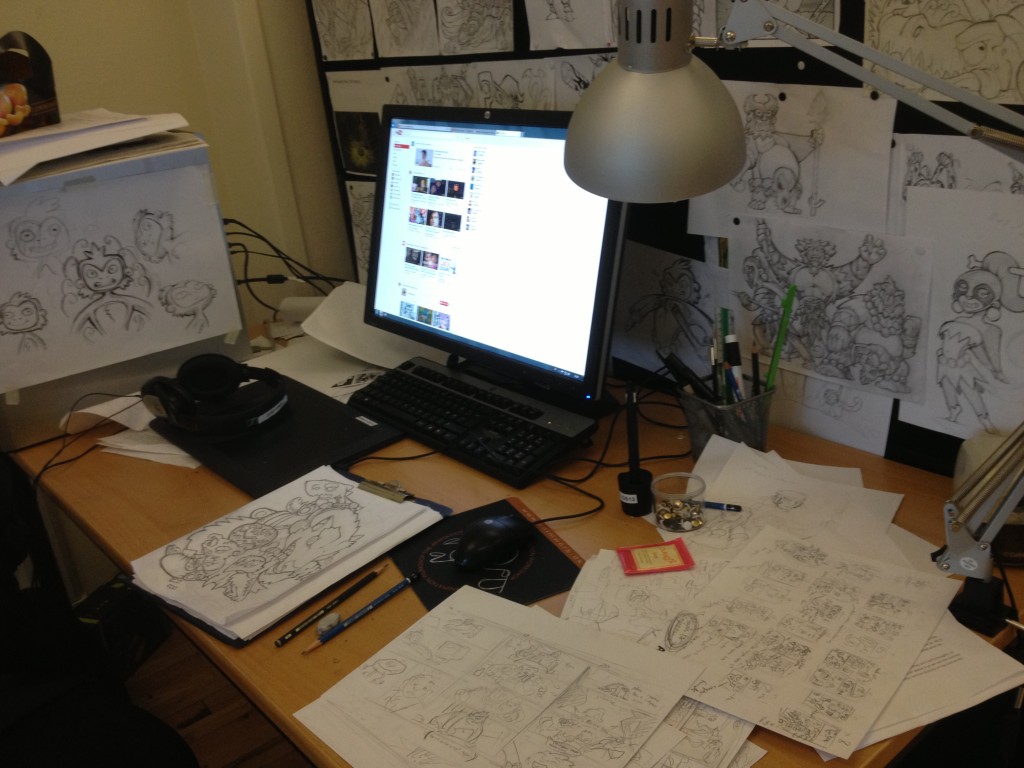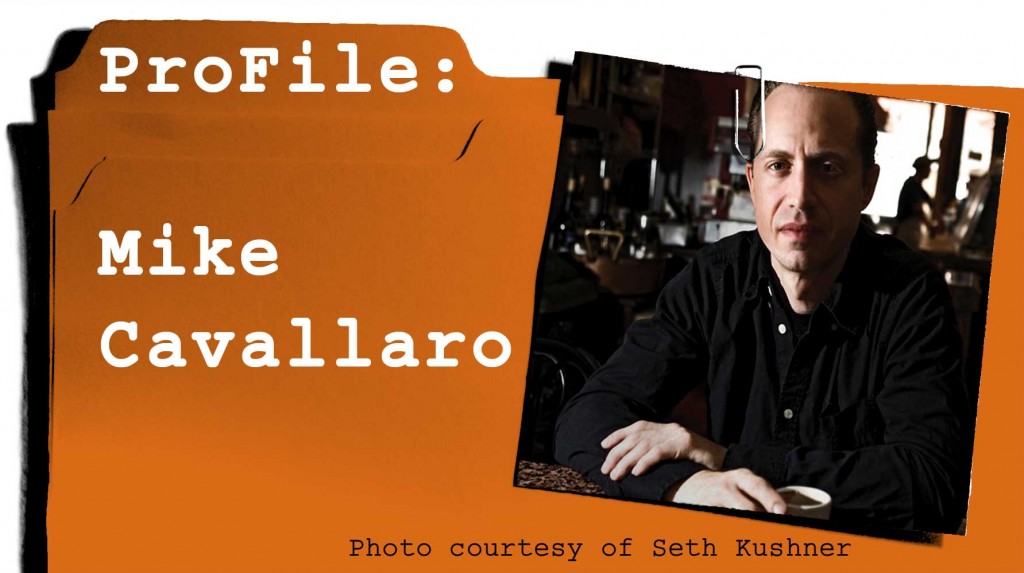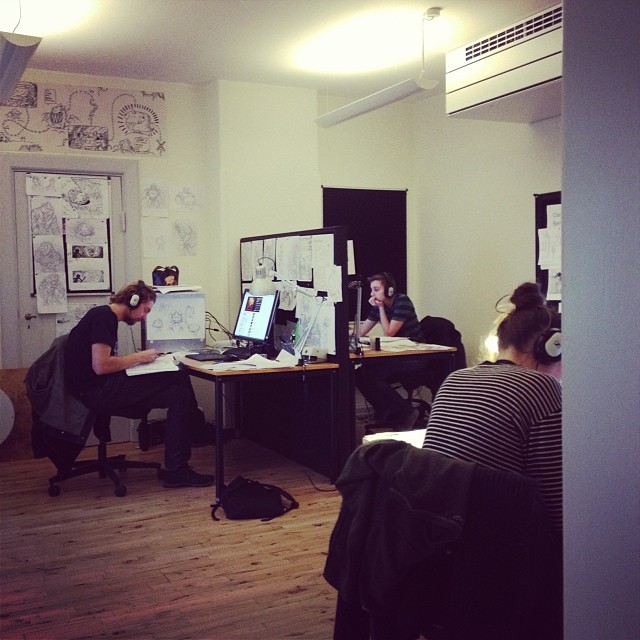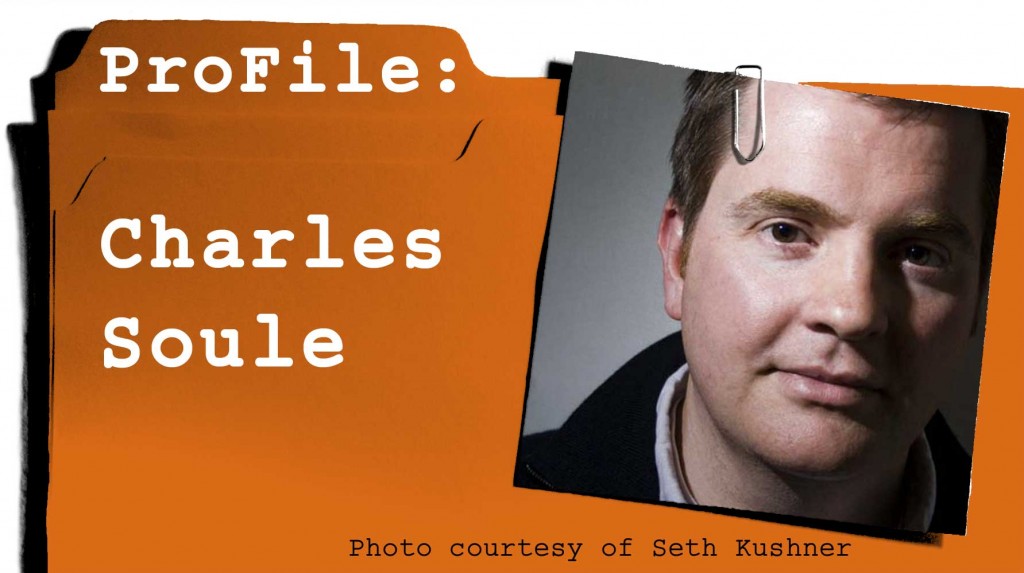Last week I taught a comics class at the Animation Workhop in Viborg. This week’s podcast is a summary of some of the things I taught – and learned myself! The main theme is choice: what kind of choices you need to make before you start drawing, and what you can do to make the process easier for yourself. As usual, your host is writer/artist Palle Schmidt.
learning
ProFile: Mike Cavallaro
Mike Cavallaro is from New Jersey, where he attended the Joe Kubert School of Cartoon Art, and has been a working cartoonist for over 20 years. His clients include DC Comics, Marvel, Image, First Second Books, Archie, MTV, Warner Brothers, Cartoon Network, and others. Mike’s comics include Parade (with fireworks), Nico Bravo & the Celestial Supply Shop, The Life and Times of Savior 28, with J.M. DeMatteis, Foiled and Curses, Foiled Again, with Jane Yolen, Recognition for Mike’s work includes YALSA’s “Great Graphic Novels For Teens” list, a Will Eisner Comics Industry Award-nomination, a Junior Library Guild selection, and others. Mike resides in New York City and is the vice-chairman of the National Cartoonists Society, Manhattan Chapter.
What made you decide to work in the medium of comics?
I was always interested in art, primarily illustration, and the more fantastic and unreal, the better. By the time I was graduating high school, I had already been working at my local comic shop for four years — it was my first job. My favorites were artists like Barry Windsor Smith, John Buscema, Frank Frazetta, Joe Kubert, Los Bros Hernandez, and of course many others. It was obvious that I was going to pursue some kind of art, and I guess I chose the one I was most influenced by at the time: comics. While other kids were applying to various colleges, I only applied to one place: the Joe Kubert School. After that, it was all comics, all the time, for the next couple years, and I guess it’s been that way ever since — pretty much the last 20 years.
What part of the process is the most challenging or frustrating to you?
All parts! Seriously, I suppose there are different degrees of “frustrating”. I mean, I’m frustrated by lettering because I don’t really want to do it, so it feels like sort of a drag to me. But, on my creator-owned stuff, there’s no one else to do it, so I gotta. But that’s more about tedium than anything else. There’s the frustration you feel when you can’t draw something the way you want and you’re erasing a hole into the paper and wasting time. But that’s somehow different. It’s not tedium, it’s coming face-to-face with your limitations and learning how to either exceed them or circumvent them in some way.
All-in-all though, the thing I find most challenging with comics is the writing. There was probably a point when I was discovering comics where I’d buy something just because it looked amazing. That’s not enough for me anymore. I need a story I’m interested in or I can’t be bothered. So I believe story (not just writing, but STORY: art and words working together) is the most challenging and important part of the whole thing.
If you could give one piece of advice to an aspiring comics creator, what would that be?
Be versatile. Don’t just do one thing, one way. Be able to shift gears, employ multiple techniques and styles, and have a command of all aspects of comics making: writing, pencilling, inking, lettering, and coloring.
Follow Mike’s work at mikecavallaro.com
Q & A at TAW
As you may know, I taught a comics course at the Animation Workshop in Viborg, Denmark last week. I’m planning a podcast about the course, that will probably go up later this week, but I also got some questions from students that I thought I would answer here. Perhaps there is some value in it for the Comics for Beginners community.
Q: When you’re working on a comic, don’t you ever want to change or ditch your story completely?
A: Yes, absolutely! Every time. But if I listened to the voice inside my head that tells me it’s not good enough, chances are I’ll never finish anything. I may decide NEVER to use this pen again or NEVER to make that same story mistake, but rarely do I change horses in the middle of the stream. That doesn’t mean I have no sense of self critique (at least I hope not), I just try to act like a pro and get it done. And whatever I learn, I take with me to the NEXT project.
I talked a bit about my collaboration with writer Chris Miskiewicz. I feel very fortunate to have met Chris and we get along very well creatively, with complete respect for each other’s work and a common goal to make the end result even better. When I described our working relationship, I got this question:
Q: How do you find a partner like that?
A: It’s probably different for everybody. First off, you don’t meet anybody if you just stay at home at your drawing board. You have to get out there. I met Chris at the MoCCA Festival in New York and we got along instantly. AND I liked the work he did. He lured me in with a smaller project, a short comic for his Everywhere! anthology on Act-I-Vate. Doing a little something together is probably a good idea to see if you’re on the same page. Test the waters. Meeting in person (and getting drunk together) is also something I would very much recommend, as it just takes the relationship to a whole other level than an online friendship. It frees up the communication.
Another question that was asked was about making a living as an artist and starting out:
Q: When did you decide to become an artist?
A: I didn’t, really. For a looong time I didn’t even ALLOW myself to think it was possible. I didn’t know anybody who made a living drawing, and my parents certainly didn’t either. So like the good parents they were, they persuaded me to get an education and/or a REAL job. Well, I botched thatcompletely. Never got a degree, but was working on illustration, comics, fanzine production while pretending to be a good student at the university and later the school of architecture here in Copenhagen, Denmark. It wasn’t until I met Peter Snejbjerg (artist of Books of Magic, Starman, Preacher and numerous other US books), that I realized being an artist could be a profession and not just a hobby. Starting at Gimle Studios alongside Peter and a bunch of other pros made me what I am today. If not for them, I probably would have given up. So finding a peer group and a studio spot was key for me. AND running out of money, so I HAD to make it work!
It was a great experience to meet all the talented young people in Viborg. Thanks to Aske, Fie, Kristian, Muir, Bob, Maria, Emil, Cathrin, Siri, Jacob, Eydi, Jam, Albert, Mathilde, Line, Clara, Julie, Nilas, Mette and Sofie for the opportunity to offer some guidance. Soon I’ll be asking YOU for advice!
ProFile: Charles Soule
Charles Soule is a New York based comics writer and musician. He is best known in comics as the creator of Strongman, 27, Letter 44 and Strange Attractors. He currently writes Superman/Wonder Woman, Swamp Thing and Red Lanterns and for DC comics and Thunderbolts and She-Hulk for Marvel.
What made you decide to work in the medium of comics?
Much like many (even most) comics creators, I’ve loved the medium since I was very young. Some of the first stories I ever read were comics. I’ve always loved writing, and commenced the idea of doing it as a career by writing a few novels. That was a phenomenal experience, and gave me a great deal of discipline as a writer, but it was also a bit solitary and frustrating. When those novels did not immediately catapult me into the upper echelons of the literary world, I turned to comics because of the shorter turnaround time and collaborative aspects. I began with a few shorts, and then as I gained confidence and understanding, longer works. My first publication deal happened in late 2007, and it’s been onwards and (hopefully) upwards from there.
What part of the process is the most challenging or frustrating to you?
I’m having a hard time answering this one, because for the most part, I have truly enjoyed almost all aspects of the comics-creation process. I suppose I don’t like it when writer and artist are totally out of sync, or can’t come together to discuss or compromise. That doesn’t happen very often, but it’s always a drag when it does. Part of the joy of making comics is kicking an idea back and forth between the various creators involved to make something better than any of them could have done alone (again, hopefully). If you can’t get there, then a lot of the point is lost, to my mind. No one’s idea is so perfect that it can’t be improved.
If you could give one piece of advice to an aspiring comics creator, what would that be?
I have two pieces of advice – first, never stop working on your craft – write, draw, color, letter even if you know what you’re working on at that moment will never see the light of day. It’s all valuable – you can’t ever overhone your skills. And second, don’t rush things. You don’t get to write Batman (or whatever your top tier goal may be) right away. Don’t bring your stuff out until it’s ready – and “ready” is very simple to define, to my mind: ready = “at least as good as whatever other stuff is being published for the audience you want to reach.” And again, don’t stop. It’s a long road, but it’s so rewarding.
More about Charles Soule at http://charlessoule.wordpress.com/
Dean Haspiel Short Cuts to Making Better Comics – Comics for Beginners podcast episode 15
Emmy-award winning artist Dean Haspiel gives some insights on the craft and business of comics, the benefits of being part of a studio community and his current work on the series The Fox with writer Mark Waid. Dean also shares what he believes to be the secret to making better comics: It’s all about hair! For more about Haspiel’s work, check out http://www.deanhaspiel.com and http://www.tripcity.net .
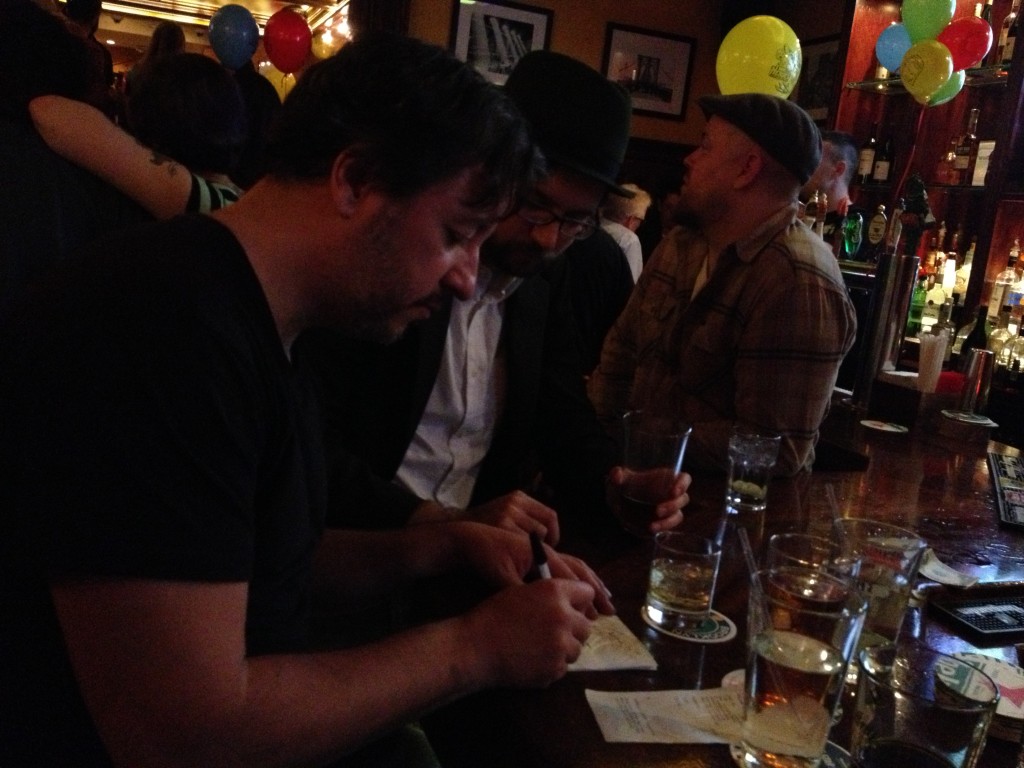
Tip of the day: PLANNING
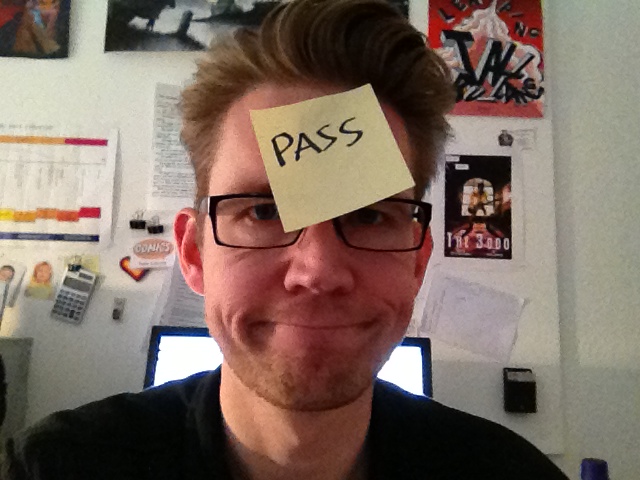
You know the term KISS – Keep It Simple, Stupid?
Today I invented the term PASS – Plan Ahead, Stupid, Stupid. (Well, it had to be four letters I think). That note is going up on my wall.
I’m kind of between projects at the moment, and I did the mistake of NOT having anything planned for today’s work.
So what happened?
Kitchen talk at the studio for half an hour and the wasting an hour on YouTube. Saw some great clips with comedian Ricky Gervais, but how does that help my work life?
So my Tip of the Day is a no brainer, something I usually practice: Plan ahead. Know what you will be working on next day, have a prioritized to-do list. An empty desk and an empty calendar is not very motivational and even though I have PLENTY of stuff I COULD do, I end up spinning the wheels all morning, going nowhere.
Perhaps I’m being too hard on myself. But who else is gonna be, right?
